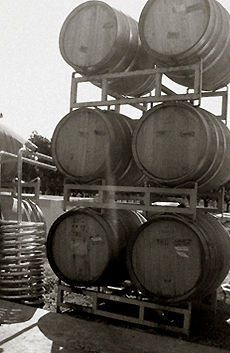2006 San Floriano Normale

This is a remarkable story, almost too much fun to tell.
In 2006, we experimented with a hillside Pinot Grigio vineyard adjacent to Farina, farmed by the superb Joe Votek, as Farina is. The intention was to make a rich but complex whole cluster pressed PG, like the clean and beautiful wines of Ronco del Gnemiz and Vie de Romans. But the fruit never gained sufficient intensity. We picked it late, hoping and hoping for it to turn a corner. It never did. We brought it in, large-berried and rather unimpressive.
So we punished it. And began a five-year program of expulsion, detention, ostracism.
First, we selected the best half-ton of fruit from the upper section of the vineyard and destemmed it into a wooden puncheon and bled away 30% of the juice. This we fermented and aged on its own—in two 30-gallon baby barrels. We bottled one almost immediately, and aged the other till last summer. We bottled that barrel as San Floriano del Collio Riserva in September.
The remaining 4 tons or so we destemmed into a large stainless tank, bled away nearly 50% of the juice and began a 7-day cold soak. After the initiation of fermentation, we began a program of one pumpover per day for about 20 days. The fermentation stuck (potential alchohol of 17%; for some reason, the puncheon went dry briskly), and we eventually put the wine down to barrel after nearly a month of skin contact.
The wine was red, the color of a light-bodied pinot noir. But it was more tannic. Much more tannic. After about a year in barrel, the fermentation finished, and shorn of sugar, the true nature of the wine appeared. It was fiercely tannic, with a light and lame strawberry fruit character-- whereas the puncheon-fermented wine was noble, impressive. This let us know that the fruit was not at fault, but the winemaking—the fermentation regime, especially all the pumpovers no doubt. This in turn allowed us to hope that if we gave the wine enough time, it would balance and restructure itself, and show an excellence of the same order as the puncheon wine. But we never enjoyed tasting it, and it tried our patience. So we segregated it in the cellar from the good students. I put it outside for the whole of the 2007 harvest. Graeme put it back out during the summer of 2009. We tasted it no more than once or twice a year. Finally, after harvest 2010, it started tasting good, very good. We put it back in the cellar with the other wines, in stacks with noble wines like Androkteinos and MSLR on either side. The tannins had knit together and turned from raw black walnut in 2006 to rich milk chocolate in 2011. The fruit had deepened and lost its strawberry character and had grown into something more like dried cherries. And the minerality hidden deep beneath sliced fruit and brutish tannins had come to the fore. We should not fail to mention that the wine developed surface yeast at various times in its life, especially during this last winter. It does not taste sherry-like, but does have kinship with Bual Madeira. We should also mention that the wine was never ever topped and will only have its first sulfur addition before bottling. After nearly 5 years in barrel.
Naturally, we will offer all of you the opportunity to taste barrel samples of this crazy wine.
The wine is called “San Floriano” after the mecca of skin-fermented white wine making, a hillside village in Collio in Friuli, in Italy up against the Slovenian border. It is the home of Josko Gravner, Stanko Radikon, and the Bensa brothers of La Castellada. In this town, to deprive white grapes of their skins is a kind of heresey, or medieval inhumanity. And the wine is called “normale” in the Italian tradition, by contrast with its sibling, the Riserva, which, paradoxically, we bottled nearly one year earlier. It was just a better student, and graduated sooner, with honors.